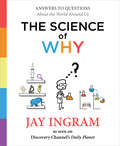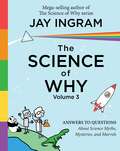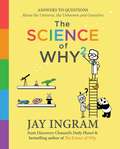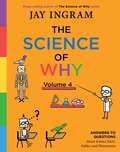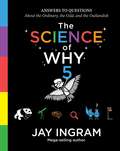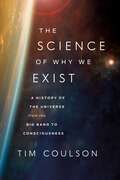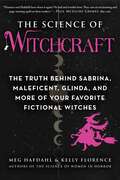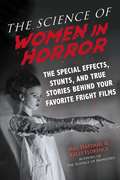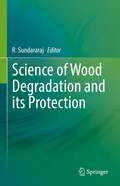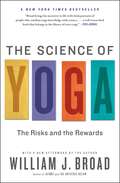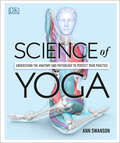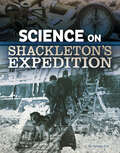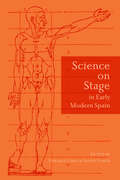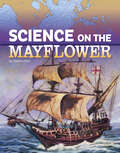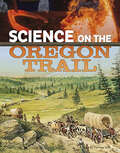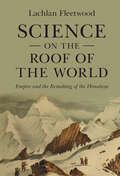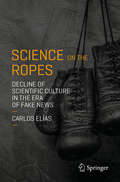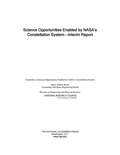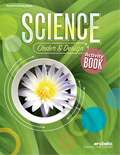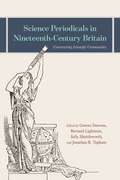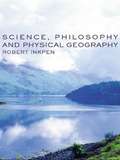- Table View
- List View
The Science of Why: Answers to Questions About the World Around Us
by Jay IngramEver wonder why onions make you cry? Or why lizards do pushups? Or why leaves change color in the fall?Don't worry, you're not alone. Acclaimed science writer and broadcaster Jay Ingram wonders the same things. After a long career of asking important questions (Does time speed up as we age? How much Neanderthal is in me? Why do some animals throw their feces?), he's here to put our scientific quandaries to rest. In this insightful, witty book for curious readers of all ages, Jay shares his favorite head-scratchers and mind-benders, settling pressing questions, such as... -What is déjà vu? -Why were Tyrannosaurus Rex's arms so short? -Why are you plagued by mosquitoes while your friends aren't? -Does your cat actually like you?* -What is déjà vu? ...along with everything you ever wondered about human echolocation, Bigfoot and farts (though not all at once). Whimsically illustrated and chock-full of fun science facts (and fictions), this book will delight and surprise your inner science geek. *SPOILER: She actually thinks you're a larger, dumber version of her mother.
The Science of Why: Answers to Questions About Science Myths, Mysteries, and Marvels
by Jay IngramThe newest volume in the beloved Science of Why series—full of fascinating science that will amuse and astonish readers of all ages.Have you wondered why you cringe when fingernails are scratched along a chalkboard? Or whether you could ever have a cybernetic limb? Or if a shark can smell a drop of blood a mile away? Then you’re in luck! Bestselling author Jay Ingram is back to answer all those questions and more as he explores and explains the world around us in all of its head-scratching curiosity. From the smallest parts inside us to the biggest questions about our universe, Jay tackles pressing topics, such as: Could we use a laser to shoot an asteroid that was about to hit earth? What exactly was a dodo and why did it go extinct? Why do beans make me fart? Touching on everything from food to robots to space to the animal kingdom, The Science of Why 3 is perfect for anyone who has stayed up late into the night pondering the weird and wonderful world we live in. Full of captivating science questions (and answers!), this book is sure to surprise and delight science readers of all ages.
The Science of Why 2: Answers to Questions About the Universe, the Unknown, and Ourselves
by Jay IngramAn all-new volume of science questions to delight, entertain, and inform readers of all ages, from bestselling author Jay Ingram.Bestselling author and commentator Jay Ingram is back to explain the magic and mysteries of the world around us. Jay takes readers on a tour of the universe, exploring wonders big and small. From the farthest reaches of space to the most perplexing historical riddles to the marvels of who we are and what we’re made of, Jay answers the important questions, such as: What’s inside a black hole? Will machines ever learn to feel? How much pee is in the average swimming pool? Because who hasn’t wondered whether we’re living in a computer simulation? Or whether Atlantis existed? Or why cats always land on their feet? With wit, wisdom, and whimsical illustrations, The Science of Why 2 will delight readers of all ages with the answers to all these questions and more. Full of fun science facts (and fictions), this is the book that everyone’s inner science geek needs to read.
The Science of Why, Volume 4: Answers to Questions About Science Facts, Fables, and Phenomena (The Science of Why series #4)
by Jay IngramBack by popular demand: a brand-new volume of science queries, quirks, and quandaries in the mega-bestselling Science of Why series, sure to enlighten and entertain readers of all ages.Have you ever wondered why we close our eyes when we sneeze? Or how far underground things can live? Or if there&’s a way to choose the fastest lineup at the grocery store? Yes? Then fasten your seat belts! Bestselling author Jay Ingram is here to take you on a rollercoaster ride through science&’s most perplexing puzzles. From the age-old mysteries that have fascinated us to the pressing unknowns about our future and all the everyday wonderings in-between, Jay answers questions that confound and dumbfound, such as: Why do zebras have stripes? How many universes might there be? Can we live for 200 years? ...along with everything you ever wanted to know about alien civilizations, photographic memories, nanobots, poop, and (conveniently) toilet paper. Bursting with laugh-out-loud illustrations, jaw-dropping marvels, and head-scratching science fictions, The Science of Why, Volume 4 will give readers of all stripes a real thrill.
The Science of Why, Volume 5: Answers to Questions About the Ordinary, the Odd, and the Outlandish (The Science of Why series #5)
by Jay IngramChock-full of peculiar puzzles, mind-bending mythbusters, and quirky questions, the fifth pop science book in the bestselling Science of Why series is perfect for anyone curious about the weird and wondrous world we live in.Have you ever wondered if octopuses are from outer space? What Mexican jumping beans are? Or if banana peels are really slippery? If questions like these are keeping you up at night, you can rest easy. Bestselling author Jay Ingram is here to answer all the whimsical and whacky wonderings that have baffled people since the dawn of time. From our bodies to our pets (and other beasts) to the natural world around us, Jay tackles science topics big and small, such as: Did dinosaurs sit on their eggs? What is our funny bone? Is there a specific muscle that makes dogs cute? Because who hasn&’t pondered whether plants have feelings? Or if Robin Hood was a real person? Or what humans will look like in the future? Teeming with amusing answers to bemusing questions—and handy and hilarious illustrations—this latest volume separates fact from fiction, lesson from legend, and myth from marvel. Endlessly illuminating and entertaining, The Science of Why, Volume 5 is five times the fun for new and old readers of the series.
The Science of Why We Exist: A History of the Universe from the Big Bang to Consciousness
by Tim CoulsonFrom the Big Bang and the evolution of the genetic code to the birth of consciousness, this is the extraordinary story of the chain of events that led to human life on earth.Have you ever wondered why you exist? What had to happen for you to be alive and conscious? Scientists have come a long way in answering this question, and this book describes what they have found out. It also examines whether our existence was inevitable at the universe&’s birth 13.77 billion years ago—or whether we are just incredibly lucky. The book is aimed at readers who are interested in science but are not experts. Written in an entertaining and accessible style, the narrative begins by describing how scientists discover facts before taking the reader on a journey from the Big Bang to the creation of the human genome. Covering physics, astronomy, chemistry, earth sciences, the emergence of life, evolution, consciousness, the rise of humanity, and how our personalities are moulded by genes, chance, and the environment, the journey explains how the universe started as point of intense energy that over time, in our corner of the universe, resulted in our wonderful planet—and in you.
The Science of Witchcraft: The Truth Behind Sabrina, Maleficent, Glinda, and More of Your Favorite Fictional Witches (The Science of)
by Meg Hafdahl Kelly FlorenceA scientific discovery of witches in fiction—Chilled Adventures of Sabrina, Sleeping Beauty, Wicked and so many more! Kelly Florence and Meg Hafdahl, authors of The Science of Women in Horror and co-hosts of the Horror Rewind podcast called &“the best horror film podcast out there&” by Film Daddy, present a guide to the history of witchcraft through the stories and characters we all know and love. Reveal the spellbinding science behind the legends and lore surrounding fiction&’s most iconic witches, answering such questions as: What is the science behind divination and spellcraft?When did witchcraft begin to show up in literature and media?Has science made it possible to uncover the truth behind the powers of necromancy and employing familiars?How has witchcraft been thought of throughout the world? Through interviews, film and literary analysis, and bone-chilling discoveries, join Kelly and Meg as they learn about the complicated and rich science of witchcraft throughout the centuries and discover why now is the season of the witch!
The Science of Women in Horror: The Special Effects, Stunts, and True Stories Behind Your Favorite Fright Films
by Meg Hafdahl Kelly FlorenceFrom scream queens to femmes fatale, horror isn&’t just for the boys. Gothic media moguls Meg Hafdahl and Kelly Florence, authors of The Science of Monsters, and co-hosts of the Horror Rewind podcast called &“the best horror film podcast out there&” by Film Daddy, present a guide to the feminist horror movies, TV shows, and characters we all know and love. Through interviews, film analysis, and bone-chilling discoveries, The Science of Women in Horror uncovers the theories behind women&’s most iconic roles of the genre. Explore age-old tropes such as &“The Innocent&” like Lydia in Beetlejuice, &“The Gorgon&” like Pamela Voorhees in Friday the 13th, and &“The Mother&” like Norma Bates in Pyscho and Bates Motel, and delve deeper into female-forward film and TV including: The Haunting of Hill HouseTeethChilling Adventures of SabrinaBuffy the Vampire SlayerAnd so much more! Join Kelly and Meg in The Science of Women in Horror as they flip the script and prove that every girl is a &“final girl.&”
Science of Wood Degradation and its Protection
by R. SundararajThis edited book covers all aspects of wood degradation from its formation and growing in trees to its end usages when it is put into human usage. Wood is an age-old traditional fascinating material with a sensory-rich immersive experience that kindles aesthetics and creativity. The utility, durability, and functionality of wood render it a cosmopolitan material. It constitutes an integral part of human lives from ancient times to modern societies being used by various sectors viz., construction, furniture, panel products, paper and pulp, sports goods, agricultural implements, etc., Wood, being a biological material, is susceptible to degradation both by physical and biological means, and the need to protect the wood and prevent heavy economic losses constitutes a major challenge. Also, wood formed by the trees is the major sinks of carbon and the carbon remains locked-up for the life of the wood, thereby serving as important tool to mitigate the climate change. But the carbon stored in wood returns to the atmosphere when it degrades and will have positive effect on climate change. Hence, wood protection aiming for extending the service life of wood plays a key role in locking the carbon for a longer period in the wood and also substantially reduce the demand and depletion of forest resources. The book focuses on wood as an important natural bio-resource, inventory of wood protection, usage, utilization, preservatives, protection technologies and wood protection from all forms of degradation. Special focus is given on the eco-friendly way of protecting wood and its importance in mitigating climate change. The book is useful for Indian and international readers, who are working in wood domains. It is of interest to wood technologists, teachers, researchers, climate change scientists, capacity builders, and policymakers. It is of immense importance as a guide and study material to the graduate and postgraduate students of wood science in various universities of India and abroad.
The Science of Yoga: The Risks and the Rewards
by William J BroadA lead science writer for The New York Times—and lifelong yoga practitioner—examines centuries of history and research to scrutinize the claims made about yoga for health, fitness, emotional wellbeing, sex, weight loss, healing, and creativity. He reveals what is real and what is illusory, in the process exposing moves that can harm or even kill. A New York Times bestseller.The Science of Yoga draws on more than a century of painstaking research to present the first impartial evaluation of a practice thousands of years old. It celebrates what’s real and shows what’s illusory, describes what’s uplifting and beneficial and what’s flaky and dangerous—and why. Broad unveils a burgeoning global industry that attracts not only curious scientists but true believers and charismatic hustlers. He shatters myths, lays out unexpected benefits, and offers a compelling vision of how the ancient practice can be improved.
Science of Yoga: Understand the Anatomy and Physiology to Perfect Your Practice (Dk Science Of Ser.)
by Ann SwansonExplore the biomechanics of 30 key yoga asanas, in-depth and from every angle, and master each pose with confidence and control.Introducing Science of Yoga - an all-encompassing science book to help you better understand yoga anatomy and the medical science behind yoga to perfect your practice and poses!Did you know that yoga practice can help treat age-related memory loss better than brain-training games? Recent scientific research now supports what were once anecdotal claims about the benefits of yoga to every system in the body. Science of Yoga provides a detailed insight into variations of key yoga poses and the specific benefits of different styles of yoga on the human body, system by system. Dive right in to discover: - Specially commissioned CGI artworks show 30 asanas in depth and detail the physics of the pose - 16 spreads of clear, easy-to-understand scientific facts and research answering key questions around ancient and modern claims - Illustrated section on the benefits of yoga on the human body system by system - Easy-to-understand research is presented in an easy-to-understand format with illustrated pullouts, debunking the myths and explaining the scientific facts, from breathing techniques to mindfulnessScience of Yoga is a riveting read, and reveals how your blood flow, respiration, muscles and joints work below the surface of each yoga pose, whilst teaching you to achieve technical excellence in your practice, from the comfort of your own home.The first yoga book on the market to combine detailed anatomical drawings, pose mechanics and key scientific research, Science of Yoga is a must-have volume for yoga beginners and professionals alike, seeking an accessible and easy-to-read guide on the effects of yoga on the human body from a scientific standpoint. Whether you&’re looking to take up yoga this New Year, or your yoga poses are already perfect, this science book is the ideal fitness gift for the yoga lover in your life, and sets out to separate the facts of yoga from the myths, with proven scientific research.
Science (Ohio)
by Timothy Cooney Jim Cummins James Flood Barbara Kay Foots M. Jenice Goldston Shirley Gholston Key Diane Lapp Sheryl A. Mercier Karen L. Ostlund Nancy Romance William Tate Kathryn C. Thornton Leon Ukens Steve WeinbergHardbound Pupil Editions for Grades 1-6 are organized into four units-Life, Physical, Earth, and Human Body sciences. An age-appropriate workbook is available for Kindergarten students.
Science (Ohio)
by Timothy Cooney Jim Cummins James Flood Barbara Kay Foots M. Jenice Goldston Shirley Gholston Key Diane Lapp Sheryl A. Mercier Karen L. Ostlund Nancy Romance William Tate Kathryn C. Thornton Leon Ukens Steve WeinbergScott Foresman Science ( 2003)
Science (Ohio Edition )
by HarcourtThis Science, Ohio Edition contains Earth and Space Sciences, Life Sciences, Physical Sciences, Ohio Expeditions, etc.
Science on Shackleton’s Expedition (The Science of History)
by Tammy EnzSir Ernest Henry Shackleton led an expedition across Antarctica in 1914. Did you know that science played a big role in this dangerous journey? Learn how weather patterns affected the explorer in Antarctica. Find out the science behind Shackleton’s ship, The Endurance. And discover how modern technology is being used to find out even more about this adventure more than 100 years later.
Science on Stage in Early Modern Spain (Toronto Iberic)
by Enrique Garcia Santo-TomasScience on Stage in Early Modern Spain features essays by leading scholars in the fields of literary studies and the history of science, exploring the relationship between technical innovations and theatrical events that incorporated scientific content into dramatic productions. Focusing on Spanish dramas between 1500 and 1700, through the birth and development of its playhouses and coliseums and the phenomenal success of its major writers, this collection addresses a unique phenomenon through the most popular, versatile, and generous medium of the time. The contributors tackle subjects and disciplines as diverse as alchemy, optics, astronomy, acoustics, geometry, mechanics, and mathematics to reveal how theatre could be used to deploy scientific knowledge. While Science on Stage contributes to cultural and performance studies it also engages with issues of censorship, the effect of the Spanish Inquisition on the circulation of ideas, and the influence of the Eastern traditions in Spain.
Science on the Mayflower (The Science of History)
by Tammy EnzYou may have heard of the Mayflower. The ship set sail in 1620, carrying English pilgrims across the sea to Plymouth. But did you know that science played a big role in this voyage? Learn how the Mayflower was constructed. Find out how science helped sail the ship across the ocean. And discover how modern technology is being used to understand the journey and the people aboard.
Science on the Oregon Trail (The Science of History)
by Tammy EnzYou may have heard of the Oregon Trail. In the 1840s, more than 5,000 people traveled the Oregon Trail, hoping for a better life. But did you know that science played a big role in this epic journey? Learn how covered wagons were engineered. Find out how food was preserved and diseases were treated along the trail. And discover how modern technology is helping us learn even more about this time in history.
Science on the Roof of the World: Empire and the Remaking of the Himalaya (Science in History)
by Lachlan FleetwoodWhen, how, and why did the Himalaya become the highest mountains in the world? In 1800, Chimborazo in South America was believed to be the world's highest mountain, only succeeded by Mount Everest in 1856. Science on the Roof of the World tells the story of this shift, and the scientific, imaginative, and political remaking needed to fit the Himalaya into a new global scientific and environmental order. Lachlan Fleetwood traces untold stories of scientific measurement and collecting, indigenous labour and expertise, and frontier-making to provide the first comprehensive account of the East India Company's imperial entanglements with the Himalaya. To make the Himalaya knowable and globally comparable, he demonstrates that it was necessary to erase both dependence on indigenous networks and scientific uncertainties, offering an innovative way of understanding science's global history, and showing how geographical features like mountains can serve as scales for new histories of empire.
Science on the Ropes: Decline of Scientific Culture in the Era of Fake News
by Carlos ElíasIn this controversial essay, Carlos Elías addresses the worldwide phenomenon that is threatening the scientific and economic progress of Western countries. The rise and influence of magic and irrationality in the media, in social networks and at universities is a disturbing phenomenon: many Western students no longer want to pursue STEM (Science, Technologies, Engineering, and Math) careers. This lucid and well-written book addresses one of the key issues of public debate: the deteriorating state of science in Western countries and their governments, and its rise in Asian countries. The author compares two distinct models: the Spanish or Latin model, which closed the door on science with the Counter-Reformation, and that employed by a second group of countries where science was encouraged. Elías suggests that a similar development could now be taking place between Western countries (where the press, television and social science academics are becoming increasingly critical towards science) and Asia, where most prime ministers (and other politicians) are scientists or engineers. This book is intended for STEM educators (both at secondary schools and universities), scientists and academics interested in scientific culture in the era of fake news.
Science Opportunities Enabled by NASA's Constellation System--Interim Report
by National Research Council of the National AcademiesTo begin implementation of the Vision for Space Exploration (recently renamed “United States Space Exploration Policy”), NASA has begun development of new launch vehicles and a human-carrying spacecraft that are collectively called the Constellation System. In November 2007, NASA asked the NRC to evaluate the potential for the Constellation System to enable new space science opportunities. For this interim report, 11 existing “Vision Mission” studies of advanced space science mission concepts inspired by earlier NASA forward-looking studies were evaluated. The focus was to assess the concepts and group them into two categories: more-deserving or less deserving of future study. This report presents a description of the Constellation System and its opportunities for enabling new space science opportunities, and a systematic analysis of the 11 Vision Mission studies. For the final report, the NRC issued a request for information to the relevant communities to obtain ideas for other mission concepts that will be assessed by the study committee, and several issues addressed only briefly in the interim report will be explored more fully.
Science Order and Design Activity Book
by Abeka BooksDive deeper into the world of science with this fun and informative activity book! From solving a metabolic mystery crossword, labeling the anatomy of a flower, to searching for health terms in a word-hunt game, and matching the different flight patterns of birds, your child will come to love the subject of science even more. <p><p>A STEM project is also included in this book, allowing your child to perform an investigation or develop a design related to the field of science, technology, engineering, and mathematics. <p><p>Your child will develop important research skills and learn to apply the scientific method through this project. Offer your child a thorough review through the fun activities in this book. It’s a win-win solution for you and your child!
Science Periodicals in Nineteenth-Century Britain: Constructing Scientific Communities
by Gowan Dawson Bernard Lightman Sally Shuttleworth Jonathan R. TophamPeriodicals played a vital role in the developments in science and medicine that transformed nineteenth-century Britain. Proliferating from a mere handful to many hundreds of titles, they catered to audiences ranging from gentlemanly members of metropolitan societies to working-class participants in local natural history clubs. In addition to disseminating authorized scientific discovery, they fostered a sense of collective identity among their geographically dispersed and often socially disparate readers by facilitating the reciprocal interchange of ideas and information. As such, they offer privileged access into the workings of scientific communities in the period. The essays in this volume set the historical exploration of the scientific and medical periodicals of the era on a new footing, examining their precise function and role in the making of nineteenth-century science and enhancing our vision of the shifting communities and practices of science in the period. This radical rethinking of the scientific journal offers a new approach to the reconfiguration of the sciences in nineteenth-century Britain and sheds instructive light on contemporary debates about the purpose, practices, and price of scientific journals.
Science Periodicals in Nineteenth-Century Britain: Constructing Scientific Communities
by Gowan Dawson Bernard Lightman Sally Shuttleworth Jonathan R. TophamPeriodicals played a vital role in the developments in science and medicine that transformed nineteenth-century Britain. Proliferating from a mere handful to many hundreds of titles, they catered to audiences ranging from gentlemanly members of metropolitan societies to working-class participants in local natural history clubs. In addition to disseminating authorized scientific discovery, they fostered a sense of collective identity among their geographically dispersed and often socially disparate readers by facilitating the reciprocal interchange of ideas and information. As such, they offer privileged access into the workings of scientific communities in the period. The essays in this volume set the historical exploration of the scientific and medical periodicals of the era on a new footing, examining their precise function and role in the making of nineteenth-century science and enhancing our vision of the shifting communities and practices of science in the period. This radical rethinking of the scientific journal offers a new approach to the reconfiguration of the sciences in nineteenth-century Britain and sheds instructive light on contemporary debates about the purpose, practices, and price of scientific journals.
Science, Philosophy and Physical Geography
by Robert Inkpen Graham WilsonThis accessible and engaging text explores the relationship between philosophy, science and physical geography. It addresses an imbalance that exists in opinion, teaching and to a lesser extent research, between a philosophically enriched human geography and a perceived philosophically ignorant physical geography.Science, Philosophy and Physical Geography, challenges the myth that there is a single self-evident scientific method, that can and is applied in a straightforward manner by physical geographers. It demonstrates the variety of alternative philosophical perspectives. Furthermore it emphasizes the difference that the real world geographical context and the geographer make to the study of environmental phenomenon. This includes a consideration of the dynamic relationship between human and physical geography. Finally, it demonstrates the relevance of philosophy for both an understanding of published material and for the design and implementation of studies in physical geography. Key themes such as global warming, species and evolution and fluvial geomorphology are used to provide illustrations of key concepts in each chapter. Further reading is provided at the end of each chapter.
